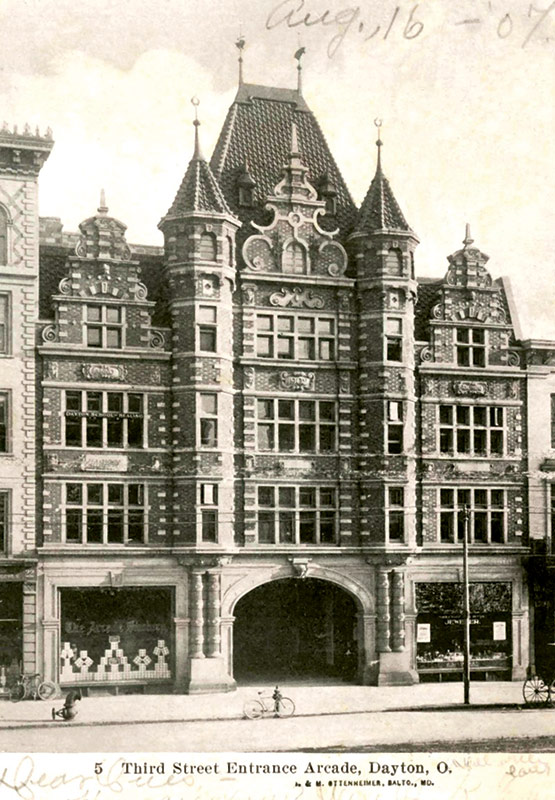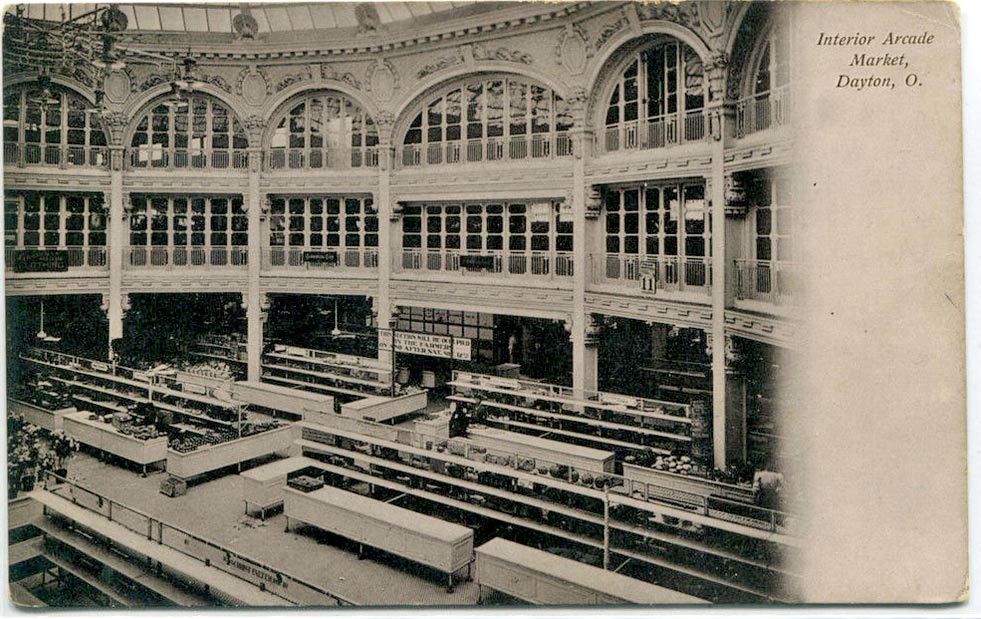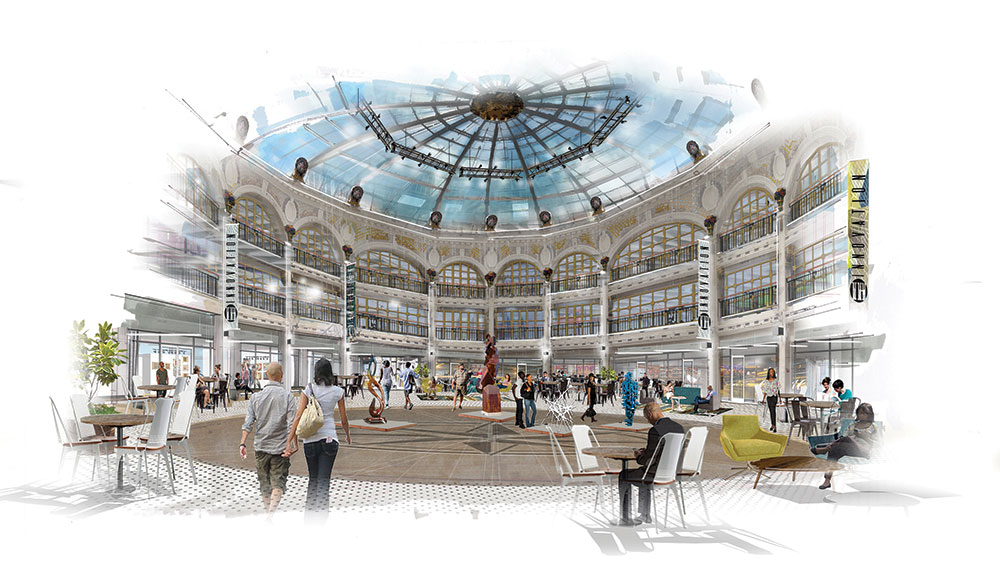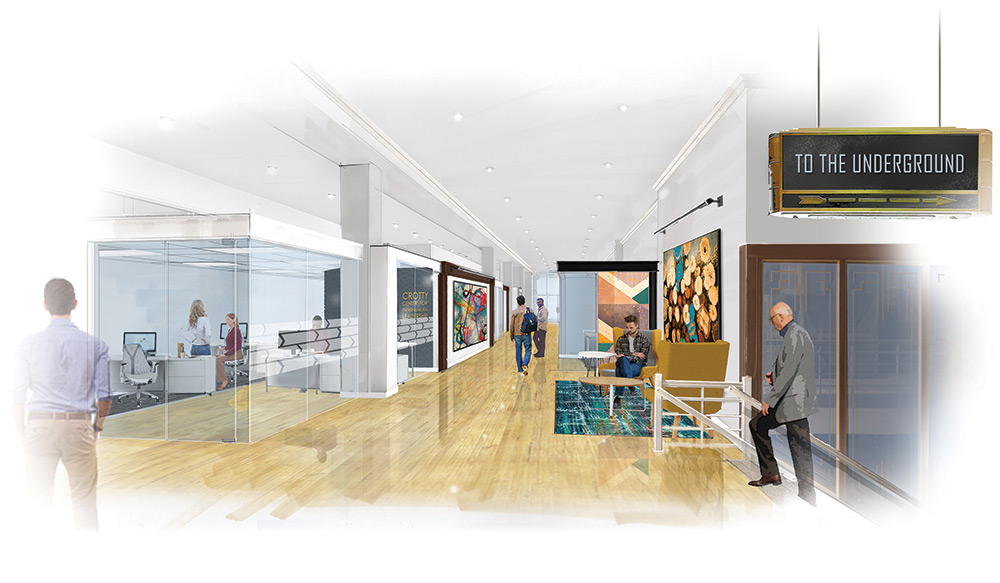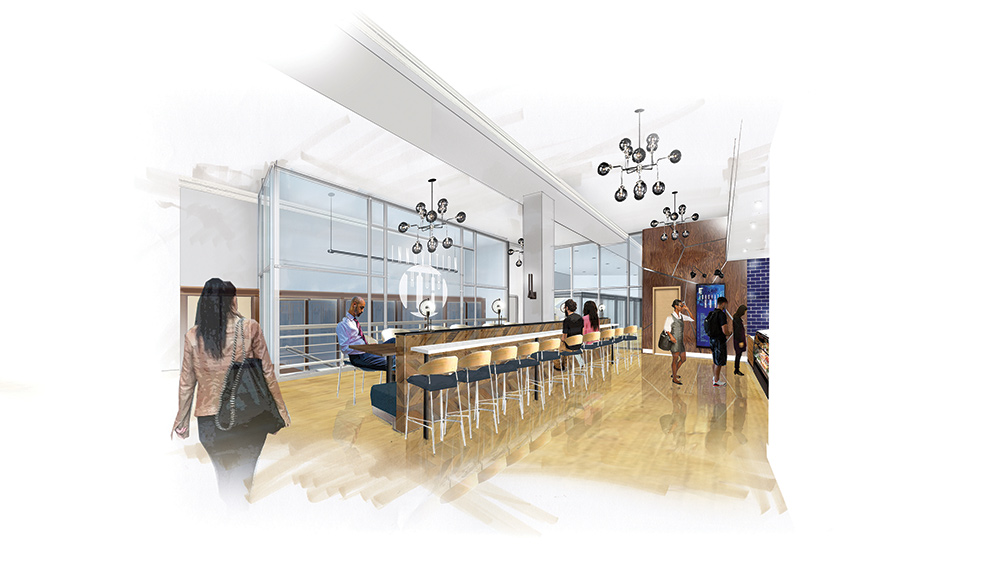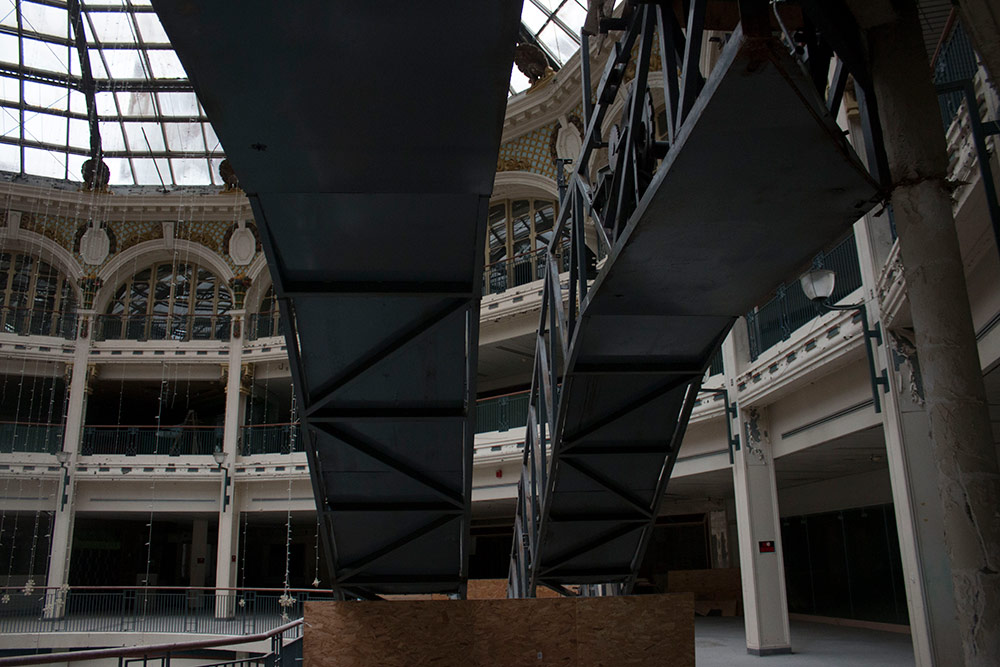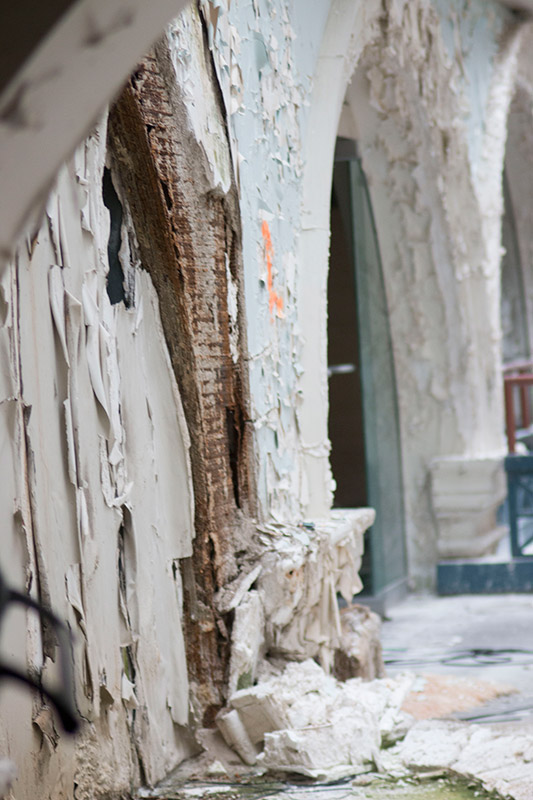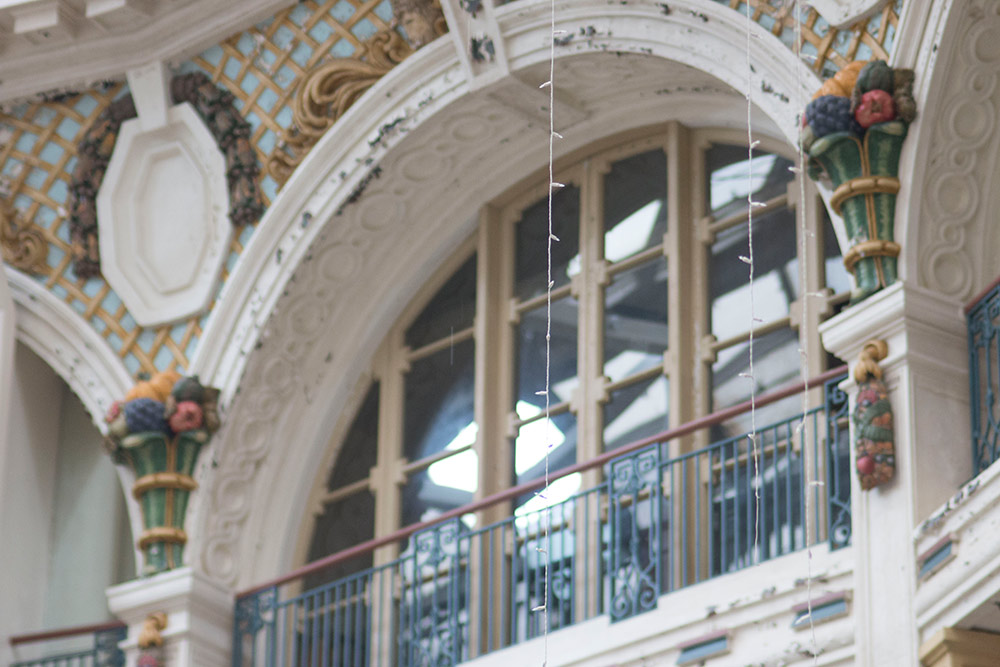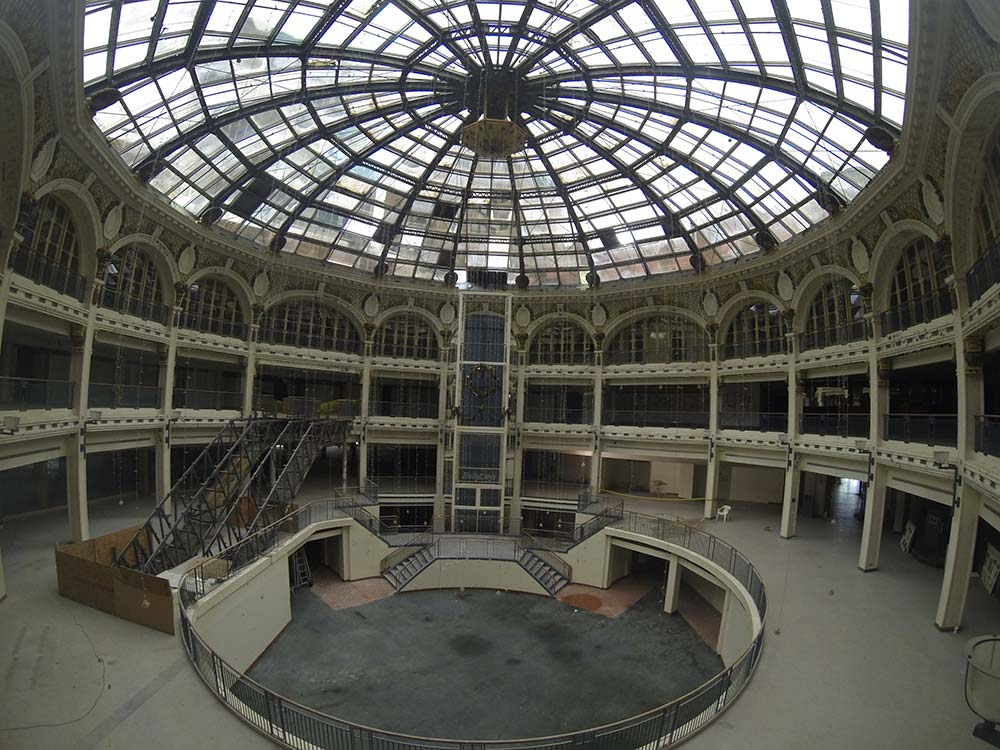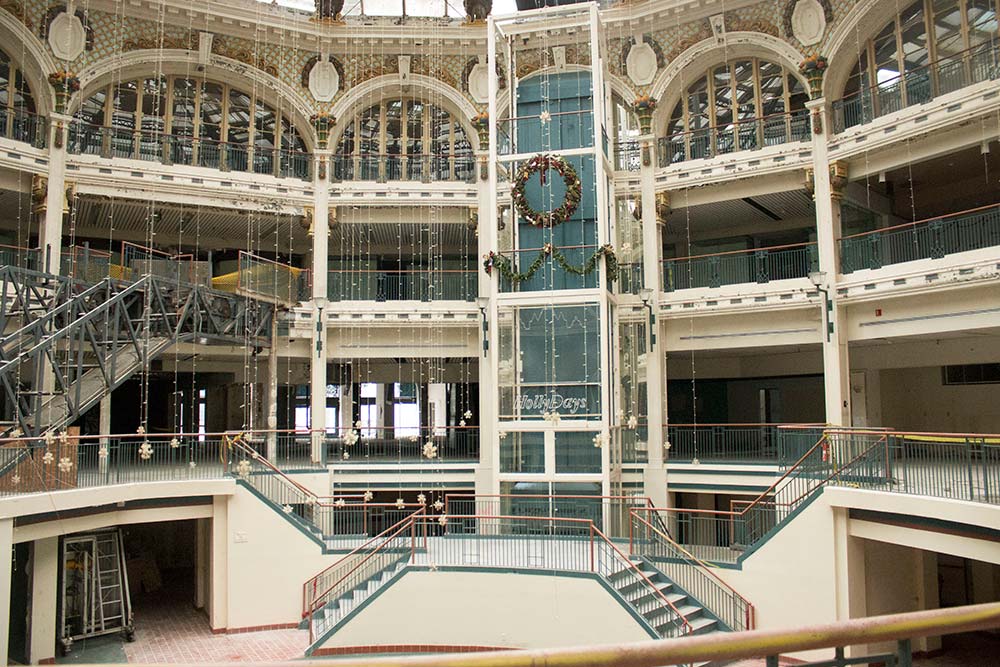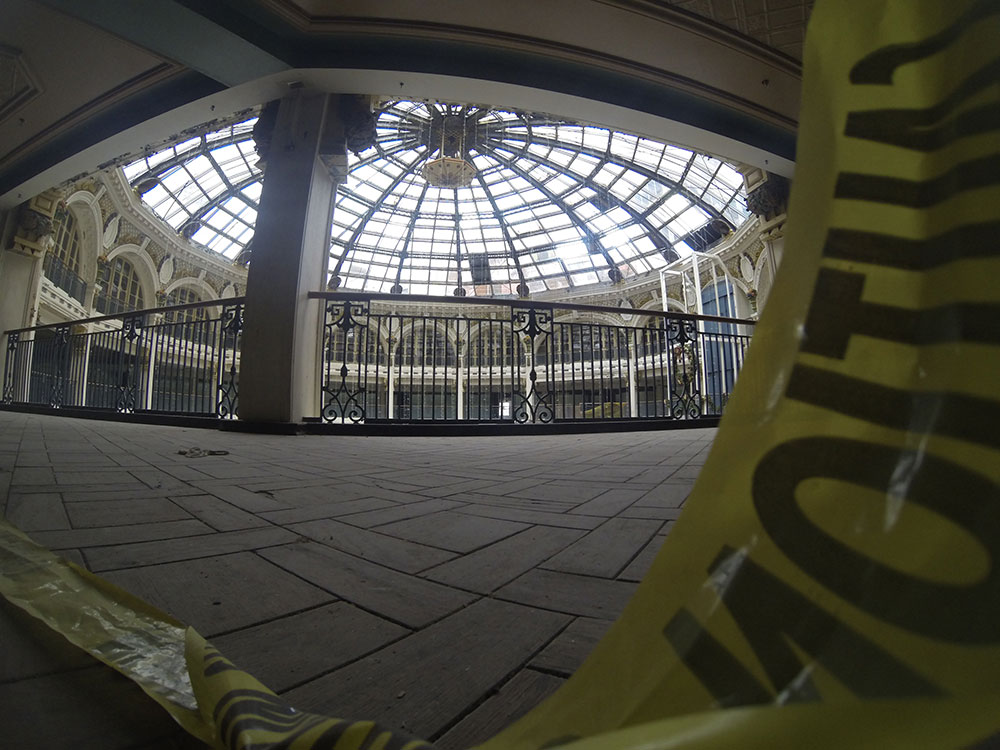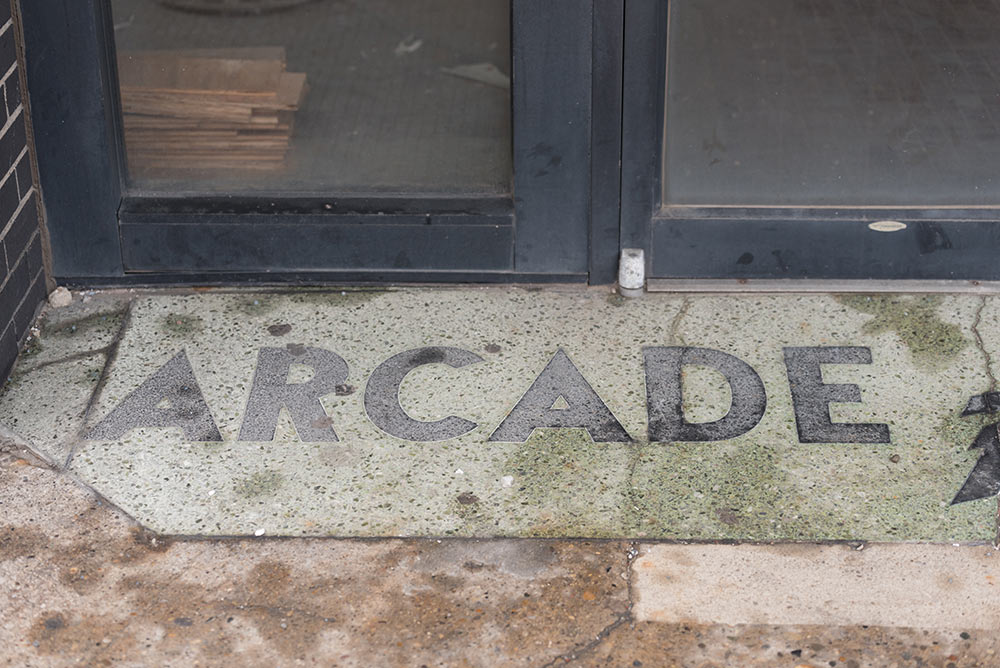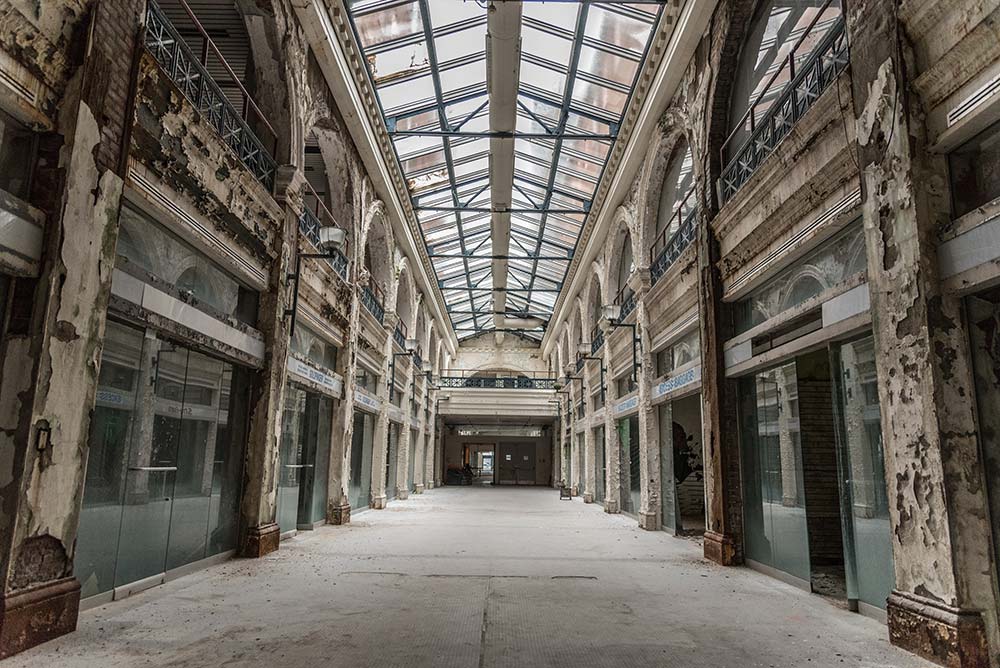Rebirth of the Arcade
Call it a tale of two centuries.
When you stand inside Dayton’s historic Arcade, you step squarely back into the city’s past.
Narrow your eyes and gaze at the three-story rotunda, until you no longer see the peeling paint and fading artificial wreaths from the 1993 Christmas season.
It is 1904 again. Upscale shoppers in feathered hats and bowlers stroll from stand to stand, booth to booth, as vendors hawk pastries, flowers, fresh vegetables and exotic fruits.
University of Dayton President Eric F. Spina couldn’t help imagining that past while touring one of Dayton’s most iconic buildings for the first time in March 2017.
“It gave me goose bumps,” Spina said. “You can feel and hear the tens of thousands of people who have walked through these halls.”
"It gave me goosebumps. You can feel and hear the tens of thousands of people who have walked through these halls."
But he could see something else, a vision of that same rotunda from the not-too-distant future: UD students working side by side with entrepreneurs, brainstorming ideas and developing and pitching new products. Sidewalks bustling with pedestrians and diners at sidewalk cafes.
“When you walk into that space, even in its current state, you can see the potential,” Spina said. “It was soaring, imposing. I could immediately picture its becoming active again, people engaged with each other, a vibrant, noisy place.”
A mere 25 minutes into the tour, Spina resolved, “Let’s make this happen.”
And the idea for the Arcade Innovation Hub was born — a place where the past will meet the future, where Dayton’s most distinctive marketplace will be transformed into a marketplace of ideas.
In April 2019, UD and The Entrepreneurs Center, known as TEC, signed a joint venture agreement and 10-year lease to become the anchor tenants and to work together to bring other community, higher education, research and corporate partners into the 95,000-square-foot Arcade Innovation Hub (click here to read UD's press release announcing The Entrepreneurs Center Arcade commitment). The innovation hub will be part of the project’s five-building, 330,000-square-foot first phase, which will include offices, small businesses, startups, classrooms, restaurants, retail, co-working spaces, artist housing and art galleries. Plans call for 108 residential units — a small number at market rate, but most earmarked for affordable housing.
It’s the answer to the Dayton community’s 29-year quest to save the beloved landmark, but the project remains laser-focused on the future. What’s proposed is nothing less radical than reclaiming Dayton’s legacy as a cradle of innovation.
“In the early 1900s Dayton had more patents per capita, more brain power per capita, bar none, than any city in the country,” said John Gower, urban design director at CityWide Development Corp. “This is the next stage, the next generation.”
In May 2018 the city of Dayton agreed to a $10 million commercial loan to the three development team partners, all heavy hitters in the urban redevelopment arena: Cross Street Partners, based in Baltimore; the Model Group of Cincinnati; and McCormack Baron Salazar of St. Louis. (City officials have committed an additional $2.5 million for residential units.) It’s Dayton’s biggest investment in more than 15 years, since the construction of the Benjamin and Marian Schuster Performing Arts Center and Fifth Third Field, the Dayton Dragons’ ballpark. And in August 2018, Montgomery County commissioners awarded $1 million to the project as part of a long-term strategy to reinvigorate the center of the city.
Dayton Mayor Nan Whaley ’98 has called the University’s involvement a “game-changer,” and Scott Koorndyk ’94, president of TEC, stated unequivocally, “This wouldn’t be happening without UD.”
Concurred Montgomery County Commissioner Debbie Lieberman ’86, “We came on board as soon as we heard Dr. Spina’s announcement that UD would be the anchor tenant. Look at all of UD’s investments in last decade — the historic fairgrounds, purchasing the old NCR headquarters. I don’t know if our community would be doing as well as we are without the University of Dayton.”
The move exemplifies the theme of Spina’s inaugural address in April 2017, “The University for the Common Good,” Lieberman said: “This will be a great private/public partnership. Dayton is known for innovation, after all, and this fits in perfectly with the renaissance that’s happening all over downtown. It’s bringing back to life a historic gem that was once the hub of downtown.”
David Williams, senior development director for lead developer Cross Street Partners, said having UD as a major player adds validity to the project. “That leadership role has been missing, and it’s great to have it,” Williams said.
Spina said the University’s involvement grew out of the question, “What can we do as a University to become an essential part of Dayton’s innovation ecosystem?”
“It’s a partnering across the University to bring Dayton back to the place it has long held as an innovation center,” Spina said. “The Arcade gives us the opportunity to be an essential part of the city and for the city to be part of us.”
The real-world advantage to students will be incalculable, predicted Liz Todia ’17, who researched potential uses of the Arcade as an undergraduate. “Working and learning in the innovation hub will show you options for being part of an entrepreneurial ecosystem before you start your own business,” she said. “And a space that is so beautiful will make you want to be there and immerse yourself in all the things that are going on.”
Community leaders call it the right plan, with the right anchors, at the right time. That’s due in part to financial incentives that weren’t available in the past, including a $5 million Ohio historic tax credit approved in 2017.
“They are putting the infrastructure in place that resets the area and provides vision, momentum, energy and new ideas,” Williams said.
"Milennials are looking for real authenticity and people who are different from them."
Just as importantly, there’s now a trend toward urban living as young people flock to the city centers their parents fled a generation before.
“Millennials are looking for real authenticity and people who are different from them,” Gower said. “Urban living is no longer a counter trend; people understand it and are starting to yearn for it. In the past, the cool new startup business was a new Chipotle. Now we’re looking for the guy who makes his own pastry.”
Only a few years ago, the Arcade seemed destined for demolition, a sad fate for an edifice that has been on the National Register of Historic Places since 1975.
The Arcade opened to great fanfare in March 1904 with a three-day celebration featuring a vaudeville show and performing bears on loan from the Cincinnati Zoo.
During the ’30s and ’40s, vendor stalls made way for more traditional retail shops. Factory workers who migrated to Dayton during World War II lived in the many apartments above the Arcade. Jammed with downtown workers, Culp’s Café inside the Arcade served up to 5,000 meals a day.
In the spring of 2019, University of Dayton history students set out to uncover the story of one of Dayton’s famed landmarks, the 1902 shopping complex known as the Arcade. The students interviewed and recorded those who worked at and visited the Arcade as far back as the 1930s. At the same time they examined archives, wrote a history of the building, and constructed a website to display what they had done. Click here to view the students' website.
In the ’80s, the Arcade re-invented itself as an urban mall, anchored by McCrory’s department store and the once-popular Charley’s Crab seafood restaurant.
The Arcade ultimately couldn’t compete with its suburban brethren, closing March 31, 1990, though “HollyDays” celebrations continued to lure more than 100,000 shoppers downtown during the 1992 and 1993 Christmas seasons.
After that, the Arcade remained empty for a quarter-century as community leaders searched in vain for a savior.
The late Dayton developer Tom Danis ’71 assumed stewardship in 1990. “He took great pains and care to make sure the buildings were secure, heated, dry and occasionally accessible to the public,” Gower said. “Tom was a great steward.”
Hopes have been raised and dashed by a dizzying array of proposals — from a bingo parlor to a pizza franchise — since philanthropist Tony Staub purchased the Arcade from Danis in 2005.
There were calls to convert it into loft apartments, a museum center, an entertainment center, a place of worship and new offices of the Dayton Daily News. Two Wisconsin-based developers spotted the Arcade for sale on eBay and purchased it at a Montgomery County sheriff’s tax lien sale for the minimum bid, but their dream of a mixed-use development never materialized.
The most daunting challenge proved the sheer size of the sprawling 420,000- square-foot complex, which covers most of a city block. “It is a city within a city with the rotunda as a spectacular secular market cathedral,” Gower said. “The Renaissance façades of Fourth and Ludlow streets are an important part of the visual symphony on Fourth Street.”
Throughout it all the Arcade’s exterior beauty remained undiminished. The Dutch Guild Hall façade on Third Street — known for its distinctive green spires and fanciful stone carvings — stood tall and proud, at once a reminder of the Arcade’s glorious past and a reproach for its present-day neglect.
“It’s the most emotional building in Dayton,” Williams said. “It’s because of the unabashed beauty, as well as all the generations and the layers of history. It’s part of our DNA.”
"It's the most emotional building in Dayton . . . It's part of our DNA."
The landmark languished. The utilities were disconnected; gutters and roof drains were not kept clean. Water seeped into portions of the buildings and vandals entered and started scrapping for copper and aluminum. Windows were boarded up to keep the glass from shattering.
“It was very sad when the city started looking at quotes for what it would cost to demolish it,” said Brady Kress, president and CEO of Dayton History. “A city loses its character when you lose those unique architectural structures that make us downtown Dayton and not St. Louis or Denver.”
In 2016 Cross Street Partners proposed a $75 million renovation that creates housing, offices, restaurants, retail and other uses. They began to have conversations with Spina, who saw the potential for melding academics and experiential learning with the city’s innovative heart.
Said Koorndyk, “Inherent in Dr. Spina’s DNA — in his thinking, in his vision — is an understanding that an institution like UD has to be integrated into its community. It’s not bounded by the four corners of the campus.”
After decades of inactivity, things are happening at the Arcade. Investigators are donning hard hats to inspect conditions while developers are working to complete construction documents. In December, workers began erecting scaffolding and removing peeling paint. Details of the ornate rotunda, such as the colorful plaster turkeys, have already been restored.
Following so many failed redevelopment proposals, so many heartbreaks, the Dayton community can’t help feeling wary. “Will it really happen this time?” everyone asks.
Spina understands the skepticism but, he said, “I feel fully confident that we will be cutting a ribbon on the Arcade.”
That commitment springs from the University’s long-range strategic vision for the next 20 years, which includes developing deeper collaborations with community partners and promoting innovation and entrepreneurship.
In 1920 the University made a conscious decision, Spina noted, to change its name from St. Mary’s College to the University of Dayton: “We are proud to carry the name of the city, and we are proud to engage with the city. It’s a two-way street where community and students are going back between the city and the University in a way that has never been done before.”
Williams said it’s impossible to underestimate the importance of a University-based activity in the downtown core. It is equally impossible to underestimate the impact on the city of giving students an early introduction to downtown and the many reasons to stay after graduation.
Spina said community partners play an equally crucial role: “This is not about ownership; it’s about collaboration. We recognize the need for a space that doesn’t belong to one entity.”
The Arcade innovation hub was born out of strong partnerships with community organizations such as TEC, as well as collaboration among UD campus partners, including the L. William Crotty Center for Entrepreneurial Leadership, the School of Engineering Innovation Center and the Institute of Applied Creativity for Transformation at ArtStreet, known as IACT.
The partnership between TEC and the UD began several years ago when Koorndyk began co-teaching classes with Crotty Center Director Vincent Lewis. “The partnership is built on mutual respect and complementary visions,” Koorndyk said.
Plans call for TEC to be responsible for the co-working space of the innovation hub, while UD will take charge of the academic programming.
“I can’t wait to get down there,” Lewis said. “We have a big project right now, and my colleagues and I want to play with it, but we don’t have the space.”
School of Engineering Innovation Center Director Rebecca Blust ’87 said the Arcade will not only allow her students to learn in a vibrant space, but it will also provide a familiar place for them to develop their business proposals after graduation. “We didn’t want a lot of the great ideas we have at the end of the semester to just go away,” she said.
Recent graduates such as Todia talk about the hands-on learning experiences UD currently offers and how it gives graduates a distinct edge in the job market. She lined up a job at Mutual Capital Partners, a Cleveland-based venture capital firm, long before graduation.
The interviewer’s jaw dropped, Todia recalled, when she talked about her experience with the Flyer Angels, undergraduate students who manage a million-dollar venture capital fund as part of the entrepreneurial program at UD. “He had never met a student who had that kind of hands-on experience,” she said.
The Arcade Innovation Hub will enhance that advantage.
“For the first time we will have professionals working in and among students,” said IACT Director Adrienne Ausdenmoore ’04. “If students have a great idea, they can pitch it to an established business. If an organization needs a graphic designer, they might go downstairs and find a student.”
"For the first time we will have professionals working in and among students."
Observed Koorndyk, “We are exposing students to the real world and to startup culture, while at the same time giving the community access to these brilliant young minds.”
As she fans out the blueprints, Ausdenmoore explains that the floor plans are designed to promote hands-on, experiential learning and creative, flexible learning space for students. “This is a very contemporary work style in a very historic location,” she said.
As plans now stand, the ground-floor beneath the rotunda area will feature a flexible black box theater that will serve as a “shark tank” for pitching business proposals, as well as other presentations and performances.
The second- and third-floor innovation hub will offer a mix of active learning spaces. It will become the new home base for the Crotty Center, featuring co-working space with TEC “to foster an ecosystem of collaborative innovation,” Ausdenmoore said. The concept is to create a mix of active learning spaces, nicknamed “huddle rooms,” instead of conference rooms.
The Innovation Center and IACT also plan to have satellite offices there. A first-floor ideation center will provide an exploratory showcase to share projects and interactive experiences, as well as for professors to hold classes for students from a variety of majors. The GEMnasium — IACT’s collaborative hands-on test lab located on campus in Fitz Hall — will set up a second location in a 5,000-square-foot space in the Arcade’s basement. “This transdisciplinary test lab is meant to be a whole new access point for any and all teachers and learners looking at grand challenges to the common good in our region,” said IACT Executive Director Brian LaDuca.
Small businesses and startups will be able to sublease office space, and self-employed professionals can rent a dedicated desk.
“We want to create a collision with disciplines that don’t normally hang out together: artists and entrepreneurs, tattoo artists and computer geeks, brewers and musicians,” Williams said.
LaDuca said that’s exactly what a new generation of learners is seeking: “The Arcade is a symbol of new collaborations and possibilities. It is open to every person of every demographic. A 19-year-old skater can walk in and feel welcomed, and so can a mother of four from the suburbs.”
UD’s Department of Art and Design also will create four upper-level studio classrooms and a small gallery there. Developers anticipate having the innovation hub ready sometime in the second half of 2020.
“We’re creating a learn-live-work-play-create space, a microcosm of what we envision for the rest of the city,” Gower said.
"We're creating a learn-live-work-play-create space."
Spina said he expects a bustling urban core will attract prospective students and faculty to the University: “Our fate is inextricably linked with the community’s. Students and faculty want to live in a place that is vibrant and full of the arts, dining and entertainment.”
The Arcade’s sheer beauty and uniqueness also should prove a strong draw. The developers plan to restore the rotunda to its 1904 glory. “We want to preserve the past, but to understand the form and function of the future,” Williams said.
Mused Crotty Center Director Lewis, “I often think about how Wilbur and Orville Wright would go about it today versus the early 1900s. There’s a good chance they would be part of a startup space.”
In 1904, the Arcade served as an emblem of Dayton’s newfound elegance and affluence. And today it stands poised to become the 21st century version of that — the entrepreneurial, intellectual heart of our community.
“It gives you chills,” Koorndyk said. “This ties the history of our community to the future of our community.”
A Look Inside
As part of the Arcade phase one renovation, about 15,000 square feet of the innovation hub will be dedicated to UD academic and experiential learning opportunities. This will include:
• Offices for the William L. Crotty Center for Entrepreneurial Leadership; School of Engineering Innovation Center; Institute for Applied Creativity and Transformation; and faculty from the Department of Art and Design.
• Entrepreneurship classes.
• GEMnasium transdisciplinary test lab to prototype new learning and teaching models.
• Creative maker space.
• Studio space for coursework in painting, print making, photography and graphic design.
• Student gallery space.
• Flyer Enterprises business location.
